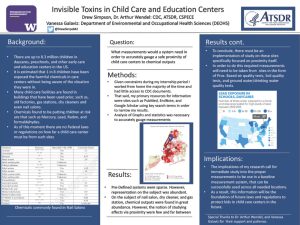Invisible Chemical Danger in Child Care Facilities
Currently, approximately 8.4 million children in the US are placed in early child care and development facilities such as preschools and day care centers. The question that currently resides at the front of the ATSDRs mind is how to keep those children safe from potential environmental harms such as chemical exposures including hazardous materials like lead, mercury, radon, formaldehydes, asbestos, etc. These risks are posed both in and around child care facilities. Contributors to these chemical outputs are business ventures such as Dry Cleaners, Nail Salons, and gas stations. For my Capstone question I have worked with the ATSDR on reviewing published chemical findings in these areas of business in order to determine what kind of measurements a tool/study would need to possess in order to accurately gauge a safe proximity for child care centers to be located away from these chemical outputs. Sufficed to say, the presence of a pre-existing set of defined measurement tools is lacking. However, various points data gathered within my research point to its creation being both possible and attainable. The implications of this research point towards the need for Prox. Based air quality tests, Soil quality tests, and ground water/drinking water quality tests displayed in a standardized format. Once these base tests are established the ATSDR will be able to set more accurate laws and regulations when creating new child care facilities, thus decreasing the endangerment of children in child care facilities.
